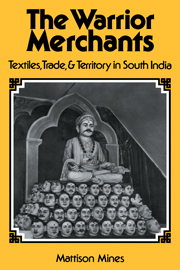Book contents
- Frontmatter
- Contents
- Preface
- Maps
- 1 Introduction
- 2 The Kaikkoolars of Tamilnadu
- 3 The Kaikkoolars and the iDangkai (left-hand) and valangkai (right-hand) castes
- 4 Kaikkoolar beliefs and the order of their social world
- 5 The naaDu system
- 6 The caste association: the Senguntha Mahaajana Sangam
- 7 Caste, politics, and the handloom weavers' cooperative movement: 1935–1971
- 8 Interpreting the Kaikkoolars today: models of caste, weaving, and the state
- References
- Glossary
- Index
- Frontmatter
- Contents
- Preface
- Maps
- 1 Introduction
- 2 The Kaikkoolars of Tamilnadu
- 3 The Kaikkoolars and the iDangkai (left-hand) and valangkai (right-hand) castes
- 4 Kaikkoolar beliefs and the order of their social world
- 5 The naaDu system
- 6 The caste association: the Senguntha Mahaajana Sangam
- 7 Caste, politics, and the handloom weavers' cooperative movement: 1935–1971
- 8 Interpreting the Kaikkoolars today: models of caste, weaving, and the state
- References
- Glossary
- Index
Summary
India is an ancient civilization and consequently immensely complex. Jumbled into India's present is a medley of traditions and contrasts with which Indians appear to be eminently comfortable. As an anthropologist working in south India, I have often felt that our accounts of contemporary Indian society fail to convey a sense of this fascinating complexity of myth, history, beliefs, and a heritage of state organizations, or even to convey a full sense of the manner in which castes are integrated into the state societies in which they have existed for thousands of years. This book is about the complexity of south India. How do all these elements-caste, history, beliefs, and state organizations fit together?
This study is oriented by four questions. First, what do we learn about south Indian society by studying artisan-merchants? Most studies of south Indian society focus on agriculturists and their dependent castes. In so doing, they tacitly ignore the artisan-merchants, who form the second largest sector of the Indian economy, or treat them as anomalous actors in an agrarian-based world. This book presupposes the importance of the artisan-merchant castes in understanding south India's complexity, and focuses on one such community, the Kaikkoolars, who are an ancient weaver-merchant caste living today predominantly in Tamilnadu State.
How is our image of south Indian society altered when we take a regional perspective? Most anthropological studies of India focus on highly localized village communities. I worked not in a single locality but within a number of localities in a traditional area of south India. This study is an examination, therefore, of weaver-merchants in the context of the organization of a region.
- Type
- Chapter
- Information
- The Warrior MerchantsTextiles, Trade and Territory in South India, pp. 1 - 10Publisher: Cambridge University PressPrint publication year: 1985

